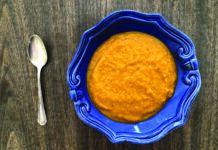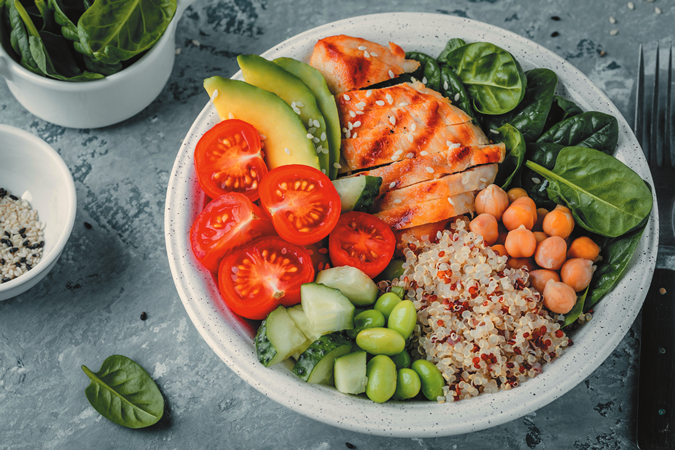Dietary guidelines are designed to suggest foods and food patterns that provide all the nutrients and bioactive compounds our bodies need, while avoiding those we don’t need (like too much sodium, starch, added sugars, and unwanted additives). MyPlate, based on the Dietary Guidelines for Americans, recommends filling half our plates with fruits and vegetables, about a quarter with grains, and about a quarter with lean protein. “When following MyPlate, the Tufts Health & Nutrition Letter recommends meeting the grain component with minimally processed whole grains, and eating plenty of nuts, seeds, fish, and poultry to maximize healthy fats, proteins, and other nutrients,” says Dariush Mozaffarian, MD, DrPH, dean of the Friedman School and editor-in-chief of Tufts Health & Nutrition Letter.
While we sometimes eat meals where each food category is separate, we often eat mixed dishes like sandwiches, casseroles, stir fries, and stews, where everything is tossed together. While at first glance it may seem difficult to think of mixed dishes in terms of MyPlate guidance, applying the recommended proportions can actually be a guide to confidently building healthier mixed-dish meals.
Choose Flavor: A recent study in the Journal of Food Science found that people enjoyed recipes prepared as low-meat/high-vegetable dishes at least as much or even more than when they were prepared as high-meat/low-vegetable dishes. These results may be in part due to the bright, colorful fruits and vegetables adding visual appeal, as well as texture and flavor. Legumes (beans and lentils), nuts, seeds, and minimally processed whole grains can do the same.
Mix it Up: Mixed dishes have great potential for increasing consumption of healthy whole plant foods. “When preparing or choosing mixed dishes, look for options in which at least half of the ingredients are comprised of nuts, seeds, fruits, vegetables, and/or beans,” says Mozaffarian. “When included, fish, poultry, or unprocessed red meat should play a supporting role.” Servings of foods like the suggestions below will be packed with nutrients and bioactive compounds (like phytochemicals and fiber) that are good for you and your gut microbiome.
Chili: Add lots of sauted veggies—along with beans (and even barley, cracked wheat, or lentils). Use a half portion of ground turkey or lean ground beef, if using (see Veggie Loaded Chili recipe on page 7).
Frittata: Saut a combination of vegetables (like spinach, tomato, mushrooms, onion, and bell peppers). Add whisked eggs and seasonings and bake until firm.
Pasta: Saut onion and garlic in olive oil. Add canned or fresh tomatoes and lots of your favorite vegetables, and season to taste. Add a touch of seafood, poultry, or unprocessed red meat if desired. Toss with a half portion of cooked noodles (try whole wheat, bean, or lentil pastas, zucchini “zoodles,” or spaghetti squash “noodles”). Top with parmesan and pine nuts, if desired.
Meatballs/Meatloaf: Try ground turkey or chicken instead of beef, and/or replace some of the meat with black beans. Add grated carrots, winter squash, or zucchini.
Pilaf: Cook a half portion of whole grain brown rice or barley. Mix in plenty of cooked vegetables like green beans, peas, mushrooms, or onions. Add toasted almonds, walnuts, or pine nuts and dried cranberries or apricots.
Sandwiches: Pile on the veggie toppings, add a side salad or fruit cup, and hold the chips and fries.
Salads, stir-fries, casseroles, stews, and soups are other great examples of mixed foods that can easily be loaded with whole plant foods. In addition to vegetables, try adding fruits and whole grains to a variety of dishes. Toss nuts and seeds into salads, stir-fries, and breads, or use them as a garnish to add crunch and nutrients to almost any dish. And don’t forget about the many convenient forms of fruits and vegetables, including pre-cut, frozen, and canned. Stocking your pantry and freezer with these foods and using parboiled or quick-cooking whole grains helps make nutritious meals quick and easy.
Following the MyPlate proportions in mixed dishes adds highly nutritious flavor, texture, and visual appeal.
-Aim for half whole plant foods (nuts, seeds, beans, fruits, and vegetables) throughout the day.
-Use a variety of colorful vegetables, fruits, and beans to replace some of the meat, poultry, and grains in mixed dishes.
-Mix grated or puréed vegetables and fruits (carrots, squash, and apple work especially well) into meatloaf, sauces, soups, and smoothies.
-Cook with a variety of whole plant ingredients and spices that jazz up color, taste, aroma, and texture.




















